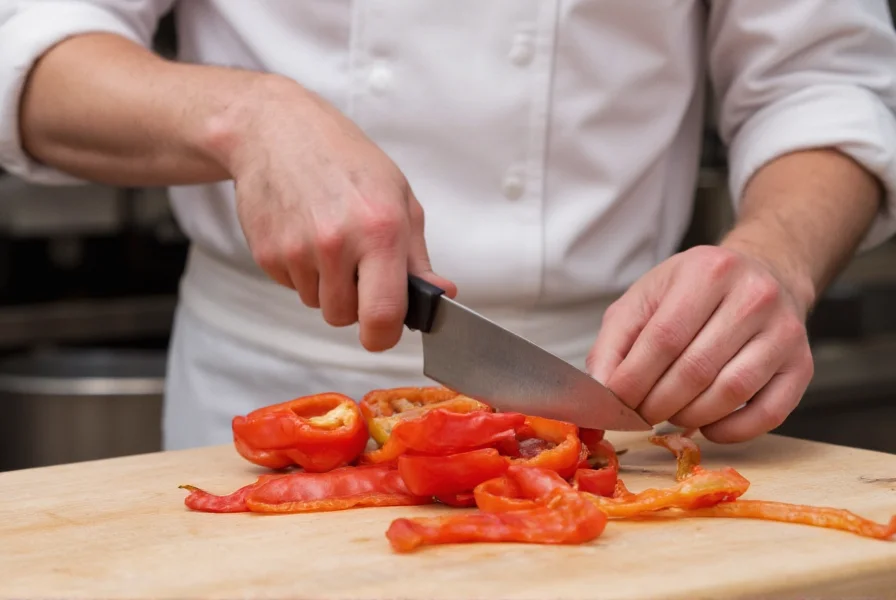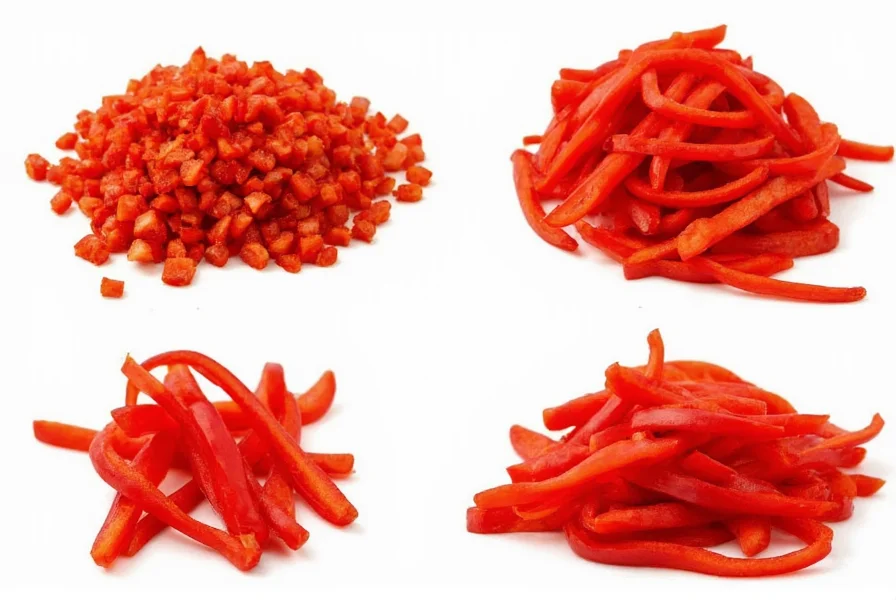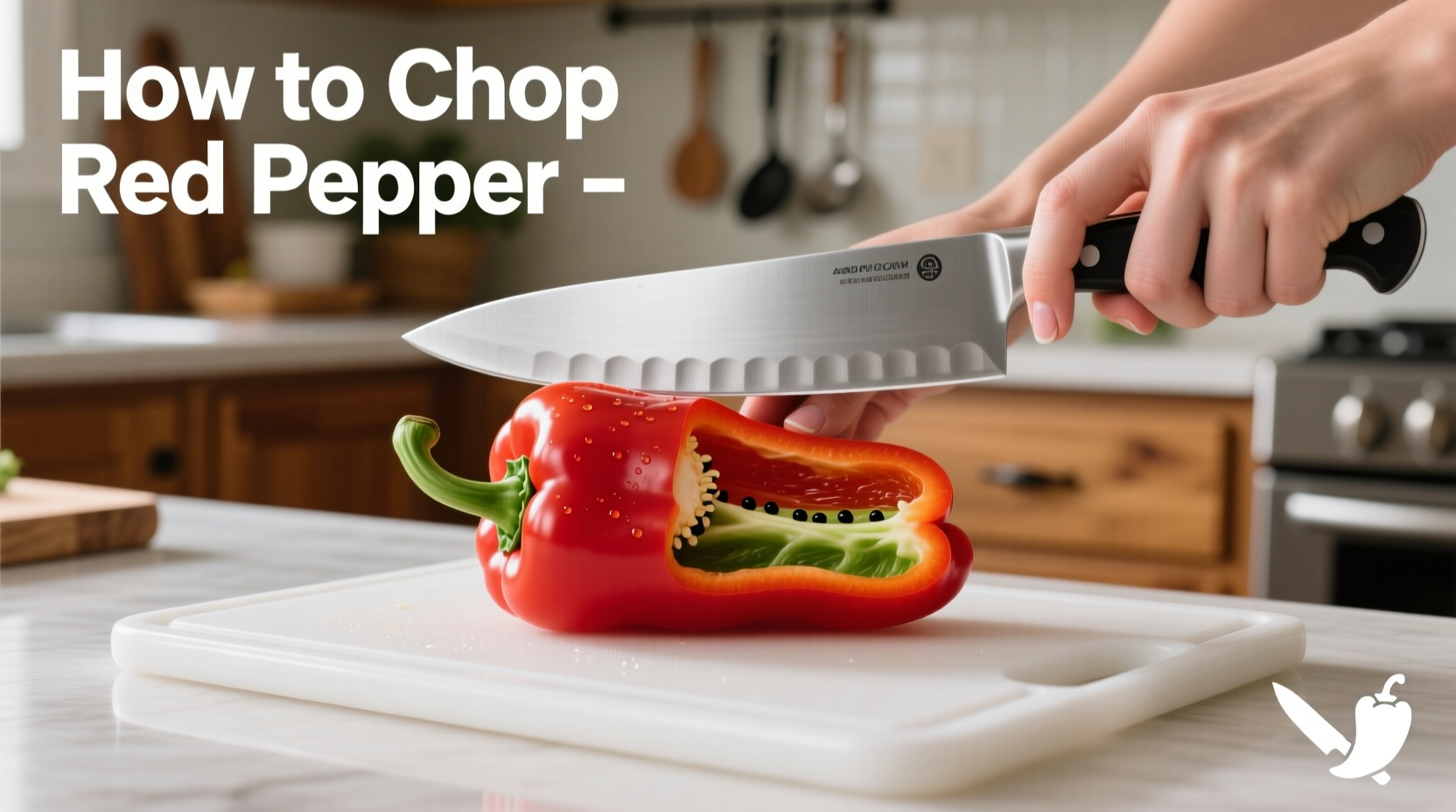Chopping red peppers properly ensures consistent pieces, maximizes safety, and preserves the vegetable's texture for cooking. Whether you're preparing a stir-fry, salad, or stuffed peppers, mastering this fundamental kitchen skill makes meal preparation faster and more enjoyable.
Essential Tools for Chopping Red Peppers
Before learning how to dice red pepper or slice it for specific recipes, gather these kitchen essentials:
- A sharp 8-inch chef's knife (dull knives are more dangerous)
- A stable cutting board (wood or plastic)
- A bowl for collecting chopped pieces
- A paper towel for handling slippery peppers

Step-by-Step Guide to Chopping Red Peppers
Step 1: Prepare Your Workspace
Clear a stable work surface and place your cutting board on a damp towel to prevent slipping. Keep your knife sharp—this is crucial for the safest method to cut red peppers. A sharp knife requires less force and gives you better control.
Step 2: Remove the Stem and Seeds
Place the red pepper vertically on the cutting board. Carefully slice around the stem in a circular motion, then lift out the core with the seeds attached. This approach to how to properly chop bell peppers prevents seeds from scattering across your workspace.
| Chopping Technique | Best For | Cutting Speed |
|---|---|---|
| Fine Dice (1/8 inch) | Salsas, sauces | ★★★☆☆ |
| Medium Dice (1/4 inch) | Stir-fries, fajitas | ★★★☆☆ |
| Julienne (matchstick) | Salads, garnishes | ★★★☆☆ |
| Thin Slices | Pizza toppings, sandwiches | ★★★★☆ |
Step 3: Flatten and Slice
Lay each pepper quarter skin-side down. Press gently with your non-knife hand to flatten—this makes how to slice red peppers for cooking much safer and more controlled. For dicing, make lengthwise cuts first, then rotate and cut crosswise.
Step 4: Master the Claw Grip
Your non-knife hand should use the "claw grip": curl fingertips inward, using knuckles to guide the knife blade. This professional technique is essential for the safest method to cut red peppers without injury. Never flatten your fingers against the pepper.

Common Mistakes to Avoid
Many home cooks make these errors when learning how to chop red pepper properly:
- Using a dull knife - requires more force and increases slip risk
- Not removing seeds first - creates slippery surfaces and inconsistent cuts
- Flat fingers on pepper - exposes fingertips to the blade
- Rushing the process - leads to uneven pieces and potential injury
When Hand-Chopping Isn't the Best Option
While hand-chopping excels for precision work, specific scenarios demand alternative approaches. Per National Safety Council guidelines, processing more than 10 peppers consecutively significantly increases repetitive strain injury risk—mechanical processors become preferable for large batches to reduce ergonomic stress (NSC Kitchen Safety, 2023). Commercial kitchens often use industrial dicers for volume efficiency, but these require specialized safety training and guards that home models lack.
Hand-Chopping vs. Mechanical Processing: Quality Analysis
Texture preservation varies significantly between methods due to cellular impact. UC Davis Postharvest Research confirms manual chopping maintains cell integrity better than mechanical processing, directly affecting nutritional retention and dish quality (UC Davis, 2015). The comparative analysis below outlines critical decision factors:
| Factor | Hand-Chopping | Food Processor |
|---|---|---|
| Texture Preservation | High (minimal cell rupture) | Moderate (blade impact causes bruising) |
| Batch Efficiency | Best for ≤5 peppers | Optimal for >10 peppers |
| Culinary Applications | Salsas, salads requiring crisp texture | Soups, sauces where texture uniformity matters less |
| Safety Profile | Risk of cuts (requires skill) | Reduced cutting risk but loading hazards |
Why Proper Technique Matters
The proper way to chop bell peppers isn't just about safety—it affects your cooking results. As documented by University of Kentucky Cooperative Extension, inconsistent sizing causes up to 50% variation in cooking rates, leading to some pieces becoming mushy while others remain undercooked (UK Extension, 2019). Uniform pieces ensure even heat distribution whether roasting, sautéing, or using raw. Professional chefs follow this principle to achieve restaurant-quality results through controlled thermal transfer.
When preparing multiple peppers, work efficiently by processing one component at a time: remove all stems, then all seeds, then slice all quarters. This assembly-line approach is part of the step by step guide to chopping peppers that saves time during meal prep.
Storing Chopped Red Peppers
Place freshly chopped peppers in an airtight container with a paper towel to absorb excess moisture. Properly stored, they'll maintain crispness for 3-4 days in the refrigerator. For longer storage, freeze chopped peppers on a baking sheet before transferring to freezer bags—ideal for future stir-fries or soups.
FAQ: Frequently Asked Questions
What's the best knife for chopping red peppers?
An 8-inch chef's knife provides the ideal balance of control and efficiency for chopping red peppers. The curved blade allows for the rocking motion that professional chefs use for precise, consistent cuts. Make sure your knife is sharp—dull blades require more force and increase the risk of slipping.
How do I prevent tears when chopping red peppers?
Unlike onions, red peppers contain minimal syn-propanethial-S-oxide (the compound that causes tears), so they rarely make you cry. If you experience irritation, chill the peppers in the refrigerator for 30 minutes before cutting, or cut near running water which helps disperse any volatile compounds.
Can I chop red peppers in a food processor?
While possible, food processors often create uneven, mushy results for red peppers. For most cooking applications requiring diced or sliced peppers, hand-chopping provides superior texture and consistency. If using a processor, pulse in short bursts and avoid over-processing to maintain proper texture.
How fine should I dice red peppers for salsa?
For traditional salsa, aim for 1/8-inch dice (fine dice) to ensure the peppers blend well with tomatoes while maintaining some texture. This size allows flavors to meld properly while providing the characteristic chunky consistency of fresh salsa. Use a sharp knife and consistent cutting technique for uniform pieces.











 浙公网安备
33010002000092号
浙公网安备
33010002000092号 浙B2-20120091-4
浙B2-20120091-4